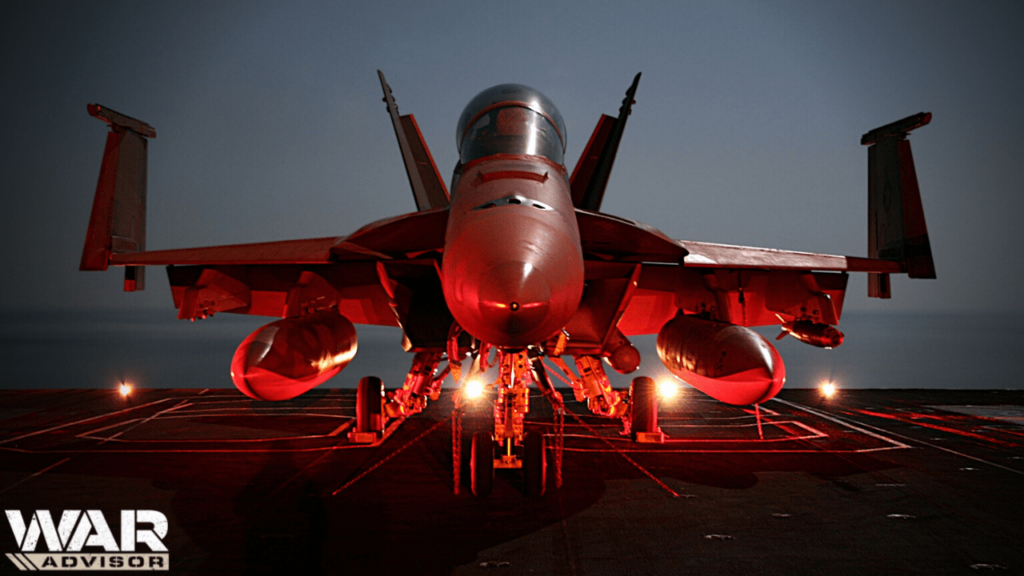The F 16 Fighting Falcon and F/A-18e Super Hornet fighter planes may seem very similar.
Both are fixed-wing fighter planes employed in various combat situations and often fill the same role. Both are US fighter planes and are often used by the US Navy.
However, despite apparent similarities (and the ability to fill many of the same roles), there are considerable differences between the two planes.
Let’s take a look at some of the biggest as we compare the F16 vs F18.
Speed
The F 16 Fighting Falcon (nicknamed the ‘Viper’) is an impressively fast aircraft, reaching speeds of over Mach 2 – about 1500 miles per hour.
Typically, however, it rarely needs to go this fast and stays at cruising speeds of 580mph.
On the flip side, the F 18 Super Hornet tops at about Mach 1.5, or around 1200mph. Its cruising speed is much higher, however, at approximately 780mph.
Whilst the F 16 is the winner in a straight-up contest of raw speed; the F 18 can go faster for longer stretches.
Engines

The difference in speed can be partially attributed to the difference in engines between the two aircraft.
The F 16 is a mono-engine jet, sporting a single turbofan engine that allows it to reach a maximum speed much higher than the F18 Super Hornet due to its lower weight.
However, having a single engine has drawbacks; the F16 must immediately land in any engine trouble.
Conversely, the F 18 is much more of a workhorse, with twin engines working to power its higher cruise speed at the expense of top speed and manoeuvrability.
The extra weight, length and aerodynamic wing drag may limit the agility of this craft on a mission, but a two-engine setup does facilitate redundancy; the F 18 can lose an engine and stay on target, unlike the nimble but comparatively fragile F 16.
Radar Capabilities
Though both flying fighters pack excellent aviation radar capabilities, it’s generally held that the F18 sports the superior package.
Favoured by the US Navy, this military craft excels at locking down enemy craft (or ground targets) with superior radar capabilities, then jamming them and rendering them blind. This leaves them wider open to the F 18’s formidable ordnance.
The F-16, while not as suited for long-range warfare, is well suited to a close-range dogfight due to its nimbleness.
Combat Records of The F 16 vs F 18

Combat records are a little more difficult to compare because the F-16 has seen so much more combat than the F18.
The former saw extensive action in the Israel-Lebanon War of 1982 and has also been deployed by the USA in the Gulf conflicts.
The latter, though deployed in several conflicts, only saw action in the Gulf War.
The F 16 has 76 confirmed air-to-air kills, only one air-to-air loss, and five losses to ground fire. It was most successful in the 1982 Lebanon War, where it claimed 44 enemy scalps in air-to-air combat.
Conversely, its least successful sortie was in the Gulf War, where it saw no air-to-air combat but lost 3 of its number to ground fire.
The F 18 has a sparse combat record. Deployed only during the Gulf War, the craft downed three enemy aircraft, lost 1 of its number in return, and another to ground fire.
Overall, the F 16 has performed better in combat – but has a much bigger sample size to draw from.
Weapon and Combat Capabilities
Both aircraft can accommodate a diverse suite of missiles like the AIM-120 AMRAAM, although the F-16 wasn’t originally designed to carry radar-guided missiles.
The F18 has always had this capability, as it was designed to defend aircraft carriers as well as occupy the role of attack plane.
The F-18 takes the edge in overall combat capabilities; it can take off and land from an aircraft carrier, making it easier to insert into combat spaces in general, and it has a longer effective combat range (about 400 nautical miles, in comparison to the F16’s 300 or so).
The F-16 has the edge in a military dogfight due to its comparative agility and increased ability to handle G-forces.
It also has a longer effective mission time due to its lower fuel consumption and ability to stay in the air longer.
Cost

The F-16 is the more economical of the two craft, coming in at around $30 million per aircraft. Conversely, the F 18 is a hefty $67 million.
Costs per hour are also a factor, given how much jet fuel the two planes burn. The F 16 costs around $8,000 per hour to keep in the air, while the F18 costs around 25% more, coming in at about $10,500 to keep aloft.
Global Air Force Distribution
Due to its solid combat record and relative inexpensiveness, the F-16 is found in the US Armed Forces and other countries worldwide.
The national air force of countries as diverse as Bahrain, Singapore, Thailand and Venezuela all use the fighter jet, along with many more.
The F 18 is newer and more expensive, but it is not found as widely as the F 16. However, countries such as Canada, Australia and the US do include it in their fleet.
Dogfighting Capabilities

The F-16 easily wins here – with a ceiling of 55,000 feet compared to the 36,000 feet of the F18, the lighter jet can reach much higher altitudes.
This, along with its superior manoeuvrability and capacity to withstand greater G-forces, makes the F16 the clear winner.
Aircraft Design
In a nutshell, the F16 is the smaller and lighter of the two craft, which explains its superior manoeuvrability and longer flight time.
However, the F18 is not completely outmatched. Boasting a superior sensor package means it’s better at long-range engagements and electronic warfare, and it can land and take off on aircraft carriers making for more tactical flexibility.
Air Force Branches
The F18 Hornet has found a natural home for itself in the US Navy. Its ability to take off and land from aircraft carriers and its relative maintainability make it a great fit for the Navy.
Its versatility is another plus point, as it can be used for Air Force carrier defence, air-to-surface assaults and recon.
The F16 is primarily used by the US Air Force (USAF), though it can also be found in the Navy and National Guard.
Conclusion To The F 16 vs F18
When it comes to the F 16 vs F 18, both jets have their pros and cons. They are used for quite different purposes.
As an all-rounder that’s earned its stripes in several actual warzones, you can’t go wrong with the F16.
Related Articles To F16 vs F18
- SOFEX 2022: Ten Epic Highlights From Drones To C130s
- Carbine VS Rifle: The Top 5 Major Differences Made Clear
However, the F18 Hornet brings a few things to the table that the F16 lacks, and it excels in dependability and long-range electronic warfare.

